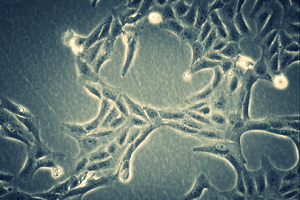Cell line profile Vero
(ECACC catalogue No: 84113001)
Cell line history
The original Vero cell line was established from the kidney of an African green monkey in 1962 by Y. Yasumura and Y. Kawakita at the Chiba University in Japan1. It is currently one of the most used continuous cell lines in the world and has been cited in over 10,000 research publications. The cell line was originally described as derived from African green monkey of the genus Cercopithecus, confusingly used synonymously with the terms Grivet and Vervet monkey. This has been replaced with the genus Chlorocebus. The species designation of Vero is commonly cited as Chlorocebus aethiops. However, recent whole genome sequencing has re-designated the species as the closely related Chlorocebus sabaeus2.
Key characteristics
The Vero cell line is continuous and aneuploid. Continuous cell lines of mammalian origin have been an extremely valuable resource for the production of biological pharmaceuticals. Vero is susceptible to infection from a number of viruses such as SV-40, measles virus, arboviruses, rubella virus, polioviruses, influenza viruses and simian syncytial viruses3. It is also susceptible to bacterial toxins including diphtheria toxin and Shiga-like toxins. Interestingly, when the whole genome of Vero was sequenced it was found there was a 9-Mb deletion on chromosome 12, which resulted in the loss of the type 1 interferon gene cluster, in addition to the cyclin-dependent kinase inhibitor genes. The authors suggested this could be the reason for the continuous nature of the cell line and its susceptibility to a variety of pathogens2.

Vero cells in the early stages (24 hours) of cell culture
Applications
Due to the continuous nature of the cell lines and its sensitivity to a number of different viruses, Vero has been used extensively in the fields of vaccine production and to study various types of emerging pathogens such as H5N1 influenza virus, middle-eastern respiratory syndrome (MERS) coronavirus, Zika virus and a number of haemorrhagic fever viruses.
A number of cell lines have been clonally derived from the parent cell line, which display different phenotypes. Vero 76 exhibits a lower saturation density and the cells are susceptible to human haemorrhagic fever viruses. Vero C1008 is a sub-clone of Vero 76. They show some degree of contact inhibition and are suitable for supporting the growth of slowly replicating viruses. Vero/hSLAM was derived by transfection of Vero cells with an expression plasmid (pCAG-hSLAM) encoding the human signalling lymphocytic activation molecule (SLAM), also known as CDw150, which is a receptor for measles virus. Vero/hSLAM cells can be used to isolate measles virus from human clinical samples and are a substitute for the B95a cell line for this purpose. Mumps susceptibility has also been demonstrated at the depositor's laboratory.
Vero (AC-free) and Vero-Hektor are both variants adapted to grow in serum free media. They are often used as seed cultures in biopharmaceutical processes.
Culture tips
Care should be taken when working with Vero and the different Vero derivatives available. Most have been clonally selected and adapted to grow on different media to the parental cell line.
|
Related cell lines |
ECACC Catalogue number |
Description |
|---|---|---|
|
Vero 76 |
Derived from Vero. Support the growth of haemorrhagic viruses |
|
|
Vero C1008 |
Derived from Vero 76. Supports the growth of slow growing viruses |
|
|
Vero/hSLAM |
Transfected Vero cell lines used to isolate measles virus from human clinical isolates |
|
|
Vero (AC-free) |
African Green monkey kidney cells, serum-free adapted to grow in animal component free medium |
|
|
Vero-Hektor |
African Green Monkey kidney cells, serum-free. This cell line is substrate dependent i.e. adherent and may be suitable for the replication of viral particles. |
|
|
MA104 |
Another African green monkey derived cell lines used to propagate simian rotavirus SA11 |
|
|
B95a |
Much more sensitive to the measles virus than the original Vero cell line. Has a similar use to Vero/hSLAM |
Key references
1. Yasumura Y., Kawakita Y. A line of cells derived from African green monkey kidney. Nippon Rinsho 21:1209-1210(1963)
2. Osada N., Kohara A., Yamaji T., Hirayama N., Kasai F., Sekizuka T., Kuroda M., Hanada K.;The genome landscape of the African green monkey kidney-derived Vero cell line; DNA Res. 21:673-683(2014).
3. History and Characterization of the Vero Cell Line -- A Report prepared by CDR Rebecca Sheets, Ph.D., USPHS CBER/OVRR/DVRPA/VVB for the Vaccines and Related Biological Products Advisory Committee Meeting to be held on May 12, 2000 OPEN SESSION
